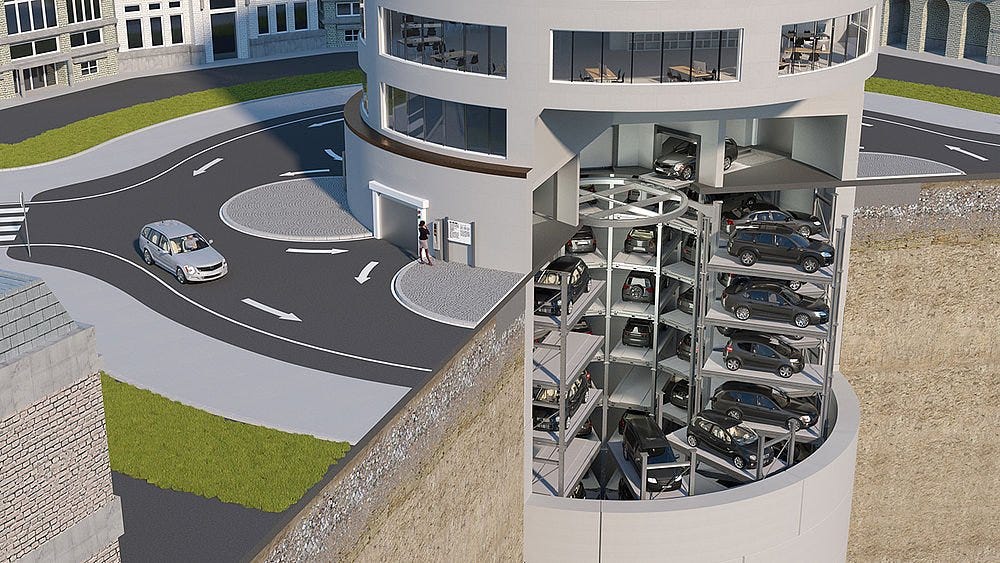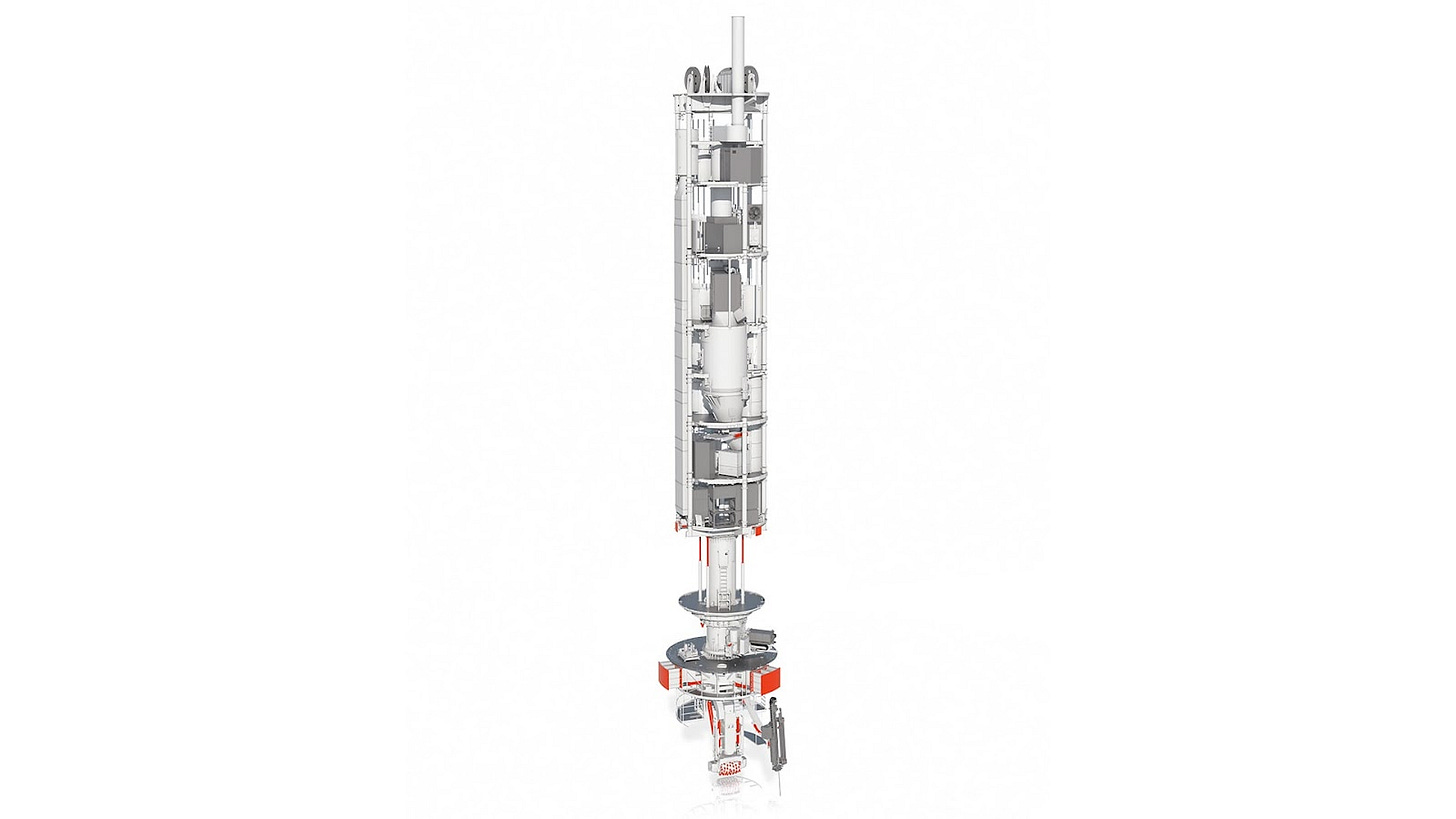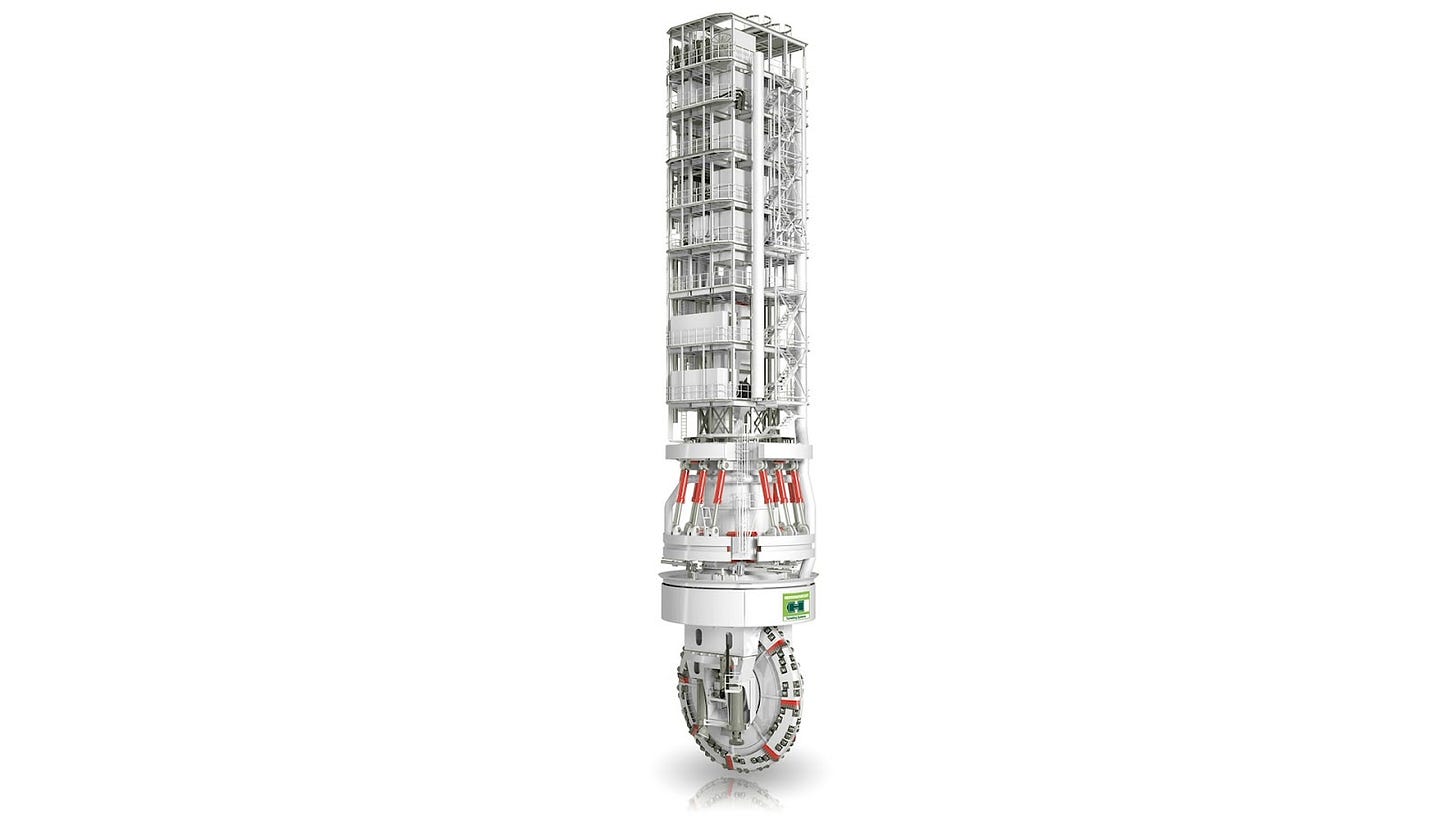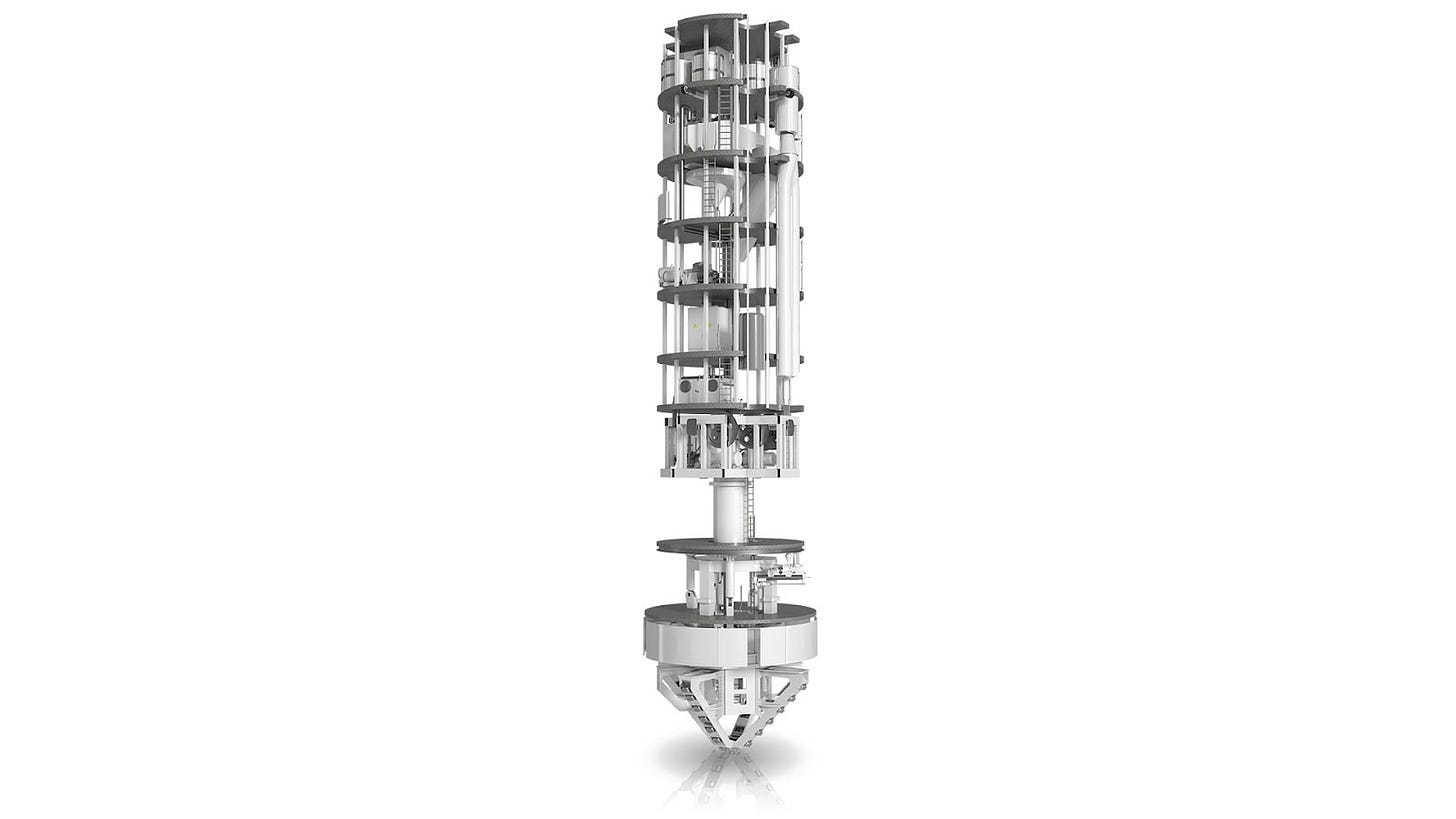A New Vertical Shaft Sinking Business
A preliminary business plan for a new vertical shaft sinking company
In an effort to think through prospective ideas, I occasionally go through the exercise of writing a preliminary business plan. The following is a preliminary business plan for a vertical shaft sinking company. Think The Boring Company, but for vertical instead of horizontal shafts.
Shaft Technologies
Mission
Decrease the cost of shaft sinking by developing vertical shaft sinking technology and leveraging vertical integration. Enable new space saving applications and engender a new ecosystem for underground habitation.
Objectives Over Next Four Months: September 2022 - January 2023
Product. Rent an existing vertical shaft sinking machine from Herenkeret. Train staff and/or leverage contractors to operate the machine.
Project Development. Draft plans for a privately funded vertical shaft project which will be used to showcase possible use cases of our shafts (storage, parking, ventilation, etc.)
People. Assemble a high caliber team that is well-versed in construction and tunneling. Recruit high-level mechanical engineering and tunnel contracting expertise.
Partnerships. Develop a partnership with The Boring Company to provide shaft sinking services for horizontal tunneling projects
Financing. Raise $15M seed financing in order to complete the initial shaft project and hire the requisite staff.
Tentative 2-year Plan
Sales. Construct 3 vertical shafts (150 feet deep, 12 foot diameter) for a price of $10M per shaft (going rate is ~$50 M).
Operations. Hire a full team capable of operating existing and newly developed shaft sinking machines by the end of the first year. Supplant such a team with a staff of ~100 mechanical engineers, software engineers, welders, civil engineers and business development leads. Build out executive org chart similar to The Boring Company.
Financing. Raise ~$50M Series A financing in order to support hiring needs. While we plan to turn a profit through contracted shaft construction, we plan to invest heavily in R&D and operate at a loss in order to build better vertical shaft sinking technology.
Problem
Shaft sinking is both slow and expensive. At the moment, shaft sinking progresses at a rate of ~2.7 m per day and can cost upwards of $1M per meter. Putting this in perspective, shaft sinking is 10 times slower than a snail (1 mile per hour) and is around 2x - 5x more expensive than conventional horizontal tunneling projects which can cost upwards of 1 billion dollars per mile. In addition to cost and speed, shaft sinking projects often involve several contractors and subcontracting agencies given that no single company is capable of servicing the entire project.
Product: Vertically Integrated Shaft Sinking
System. Shaft Technologies constructs safe, fast-to-construct, and low-cost vertical shafts to enable new space saving applications and engender a new ecosystem for underground habitation. Primary use cases for our vertical shafts will be parking, storage, sewage, tunnel boring launch shafts, elevators, ventilation and gravitational energy storage. Through vertical integration and improvements in shaft sinking machinery, Shaft Technologies dramatically reduces the cost and increases the speed of constructing vertical shafts respectively. Following the design, build, finance, operate and maintain (DBFOM) project delivery method, Shaft Technologies is able to serve as the sole contractor and maintainer for shaft sinking projects. We plan to build our own custom shaft sinking machines in house and hire the necessary staff to fully complete and maintain projects without the need for external contractors.
Speed. There are several improvements to the current shaft sinking process we aim to put in place to increase shaft sinking speed:
Automated initial excavation
Simultaneous mining and automated installation of reinforcement segments
Increase in shaft sinking machine power
Continuous dirt removal
Modified cutter design
Cost. We aim to leverage our vertically integrated shaft sinking methodology to reduce cost. Shaft Technologies aims to follow the DBFOM project delivery method and construct our own custom shaft sinking machines and hire the necessary staff to complete projects as opposed to relying on a network of contractors and externally manufactured shaft sinking machines. We also plan to standardize our shaft diameter (12 feet) which will allow us to reuse our shaft sinking machines as opposed to having to purchase or rent custom machines for every project.
Summary of Key Competitive Advantages
Lowest cost shaft sinking through vertical integration and standardization
Fastest shaft sinking through custom designed machinery
Market: Vertical Shafts
The company intends to focus initially on existing shaft utilities. Target customers are private companies and public works projects that seek vertical shafts for a range of use cases:
Tunnel boring shafts ($9B tunnel boring machine market size)
Elevators ($8B elevator market size)
Sewage ($282B sewage market size)
Ventilation ($25.8B ventilation market size)
Mine Shafts ($144B mining equipment market size)
Automated underground parking garage ($25B parking lot & garage market size)
Appendix A provides a breakdown of the number of parking spaces as a function of shaft diameter and depth
Appendix B illustrates an automated parking garage
Underground storage and fulfillment ($96B e-commerce fulfillment market size)
Gravitational energy storage ($211B renewable energy storage market size)
Currently, shaft sinking projects cost upwards of $50M and progress at an extremely slow pace. As a result, several of the above innovative use cases such as automated underground parking garages and fulfillment centers have not been explored. Shaft Technologies seeks to leverage its ability to deliver a significantly cheaper alternative (~10 M per shaft) to attract customers and enable new use cases. As opposed to engaging in conventional marketing, we plan to engage with customers through the traditional bidding process that is commonplace amongst construction and infrastructure projects with a goal of convincing clients to submit proposals with our specific specifications.
Competitors
Similar to horizontal tunnel boring, shaft sinking contractors rent or purchase shaft sinking machines for each of their individual projects. This leads to an increase in price and operational inefficiency given a lack of vertical integration. Herrenknecht, a German company that manufactures tunnel boring machines is currently the market leader in vertical shaft sinking machinery and rents equipment to shaft projects worldwide. Herrenknecht currently manufactures several types of shaft sinking machinery:
Shaft Boring Roadheader (SBR): Outfitted with a mining drum. Was developed for soft to medium-hard rock. See Appendix E for an illustration.
Shaft Boring Machine (SBM): Outfitted with a disc cutter as opposed to the pencil bits on the SBR. SBM can dig through rock and hard rock. See Appendix F for an illustration.
Shaft Boring Cutterhead (SBC): Outfitted with a conical-shaped cutter head equipped with disc cutters. Can dig through rock. See Appendix G for an illustration.
Business Model
Initially, we plan to finance shaft projects through conventional methods and receive full payment for completed shafts. For shaft projects that introduce a consistent recurring revenue stream such as an underground parking structure, we may choose to engage in a revenue share agreement with the customer and decrease the upfront cost we charge to construct the shaft.
Team
We plan to target SpaceX, The Boring Company, Herrenknecht and other prominent construction companies for an initial talent pool. The Boring Company org chart which will serve as a model as we build out our team.
Vision
While our efforts will initially focus on constructing shafts for existing utilities, we envision a future in which there is a vibrant subterranean ecosystem. Living underground conserves heat, protects residents from various natural disasters and may be the safest place to survive an impending climate emergency. Moreover, with 60 percent of the world’s population expected to be living in cities in 2050, it will be necessary to find alternative housing for the 2.5 billion new people who will want to reside in urban areas.
Living underground is not a new concept. In fact, back in 1800 BC, the people of Cappadocia (modern day Turkey) constructed an entire underground city which is still in existence today. In addition to Cappadocia, several nations such as Singapore, Mexico and Finland have already drafted plans for large scale underground business and residential spaces. Appendix C provides an illustration of what a subterranean city could look like although we envision a city made up of a series of vertical shafts as opposed to horizontal tunnels.
We plan to construct modular housing and business units that can easily be installed once a shaft is dug. Prototype systems already exist in the form of luxury doomsday bunkers. Appendix D depicts an existing underground apartment complex for affluent individuals looking to plan for the apocalypse. The subterranean unit contains its own greenhouse, swimming pool, living quarters, library, school and more.
Shaft Technologies aims to engender a new ecosystem for underground habitation which we believe will be necessary to preserve our standard of living amidst the increasing threat of climate change and overpopulation.
Anticipated Financial Expenditures September 2022 - January 2023
Salaries ($310,000)
Construction Crew (15 people at $2,500 / month + benefits)
Construction Manager ($8,000 / month + benefits)
Contracting Lead ($8,000 / month + benefits)
Mechanical Engineer ($8,000 / month + benefits)
Electrical Engineer ($8,000 / month + benefits)
Civil Engineer ($8,000 / month + benefits)
Test Shaft - 150 Feet ($5M +/- $1M)
Shaft Sinking Machine Rental ($500k / month)
Ancillary Shaft Sinking Equipment such as tanks, power supply, conveyor belts, muck removal, etc. ($350k / month)
Soft Costs such as EIS/EA, feasibility studies, permits, insurance, finance ($100k / month)
Permanent material ($150k / month)
Construction material, temporary works, consumables, etc. ($75k / month)
Modular underground storage unit ($300k)
Rent & Utilities ($20,000)
G & A - including travel and legal ($25,000)
------------------------------------------
Total Expenses: $5.4 M +/- $1M









Sorry, didn't get past snail moving at 1mph. You need to be better at checking your facts, and even more importantly have a vague idea about the world.